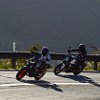If you’re a regular here on Common Tread, then you’ve already seen Spurgeon’s first ride of the Trident and newcomer Jen’s road test of the MT-07, which means you’re aware that Triumph and Yamaha are aiming their arrows at the exact same target with these bikes.
Which one hit the bull’s eye? Well, that’s what we’re here to discuss.

As a reminder, both the MT-07 and Trident are designed to be spirited all-arounders that are affordable and approachable. To that end they have identical 31.7-inch seat heights, low curb weights separated by less than the heft of the camera equipment Spenser typically carries on his back for a CTXP shoot (the Yamaha is just 406 pounds, the Trident 428, as measured on our scales), and engine sizes of 689 cc for the MT’s 270-degree parallel twin and 660 cc for the Trident’s triple. Both bikes churn out about 70 horsepower at the rear wheel (Yamaha doesn’t state power figures, but enough FZ/MT-07s have been on the dyno at this point that we know where it stands), and can be purchased for nearly the same modest sum: just $7,699 for the MT-07 and $8,095 for the Trident.
Jen, Zack, Spenser and I were all aware of these stats as we headed out for a day’s ride around Los Angeles and Malibu. What we weren’t prepared for was how the bikes' remarkably similar specs would manifest as dramatically different riding experiences.
Climb aboard
It was suggested, perhaps most enthusiastically by our shortest rider, that Triumph’s version of 31.7 inches feels lower than Yamaha’s version. That goes to show that there’s more to seat height than what the tape measure shows. Seat width, engine width, and tank width also play a role in how your lower half interacts with a bike. And despite being a triple, the Triumph is actually narrower between your knees than the two-cylinder MT, which makes it easier to dangle your legs toward the pavement.
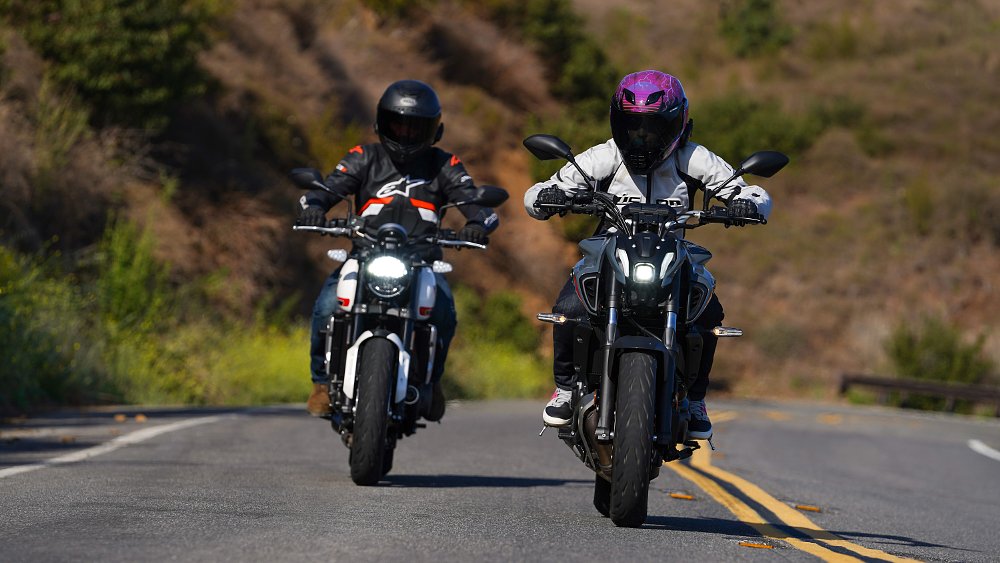
As far as seats go, Triumph offers a wider, firmer saddle that our group preferred over the Yamaha’s narrower, squishier cushion. A soft seat may feel great at first, but in my experience you often end up with pressure points, especially if the suspension isn’t well calibrated. We’ll get to that…
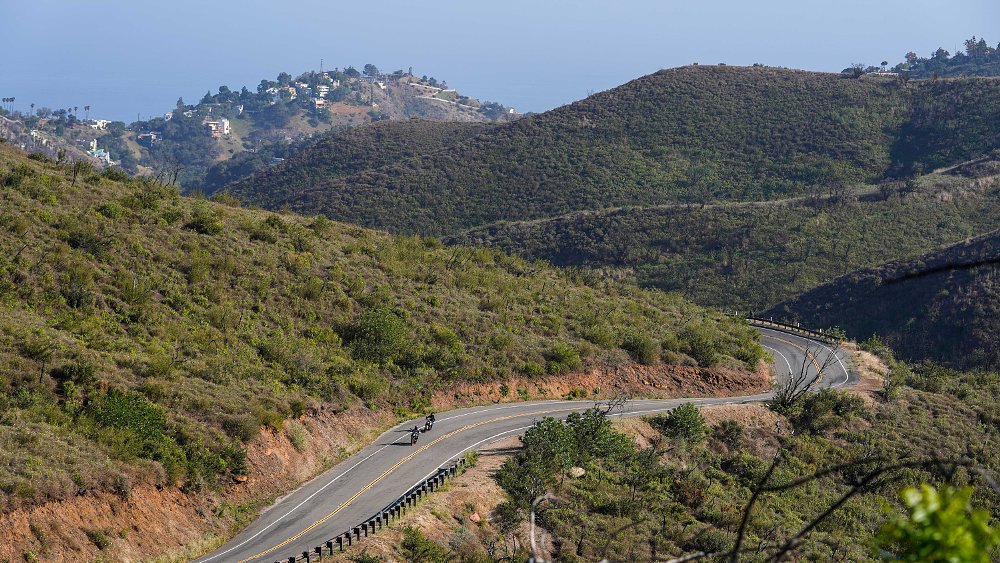
The Triumph’s handlebar is narrower, and feels taller than the MT’s, despite the Yamaha having a repositioned bar that’s nearly an inch higher and 1.25 inches wider than before. Both bikes leave you in a relatively upright riding position that’s a touch short on legroom for taller riders, but in no way cramped. A small circular dash is in front of the bar on the Triumph in classic fashion, while the Yamaha’s wide octagonal dash mounts directly above the bar. I’d say this is simply a stylistic difference, except that the MT’s arrangement necessitates positioning the ignition switch above the headlight in a spot that’s awkward to reach.
Turning gas into go
Triples have always had soul, while parallel twins have historically been the blandest way of turning gasoline into forward motion. Let’s flip that on its head, shall we?
The engine in Yamaha’s MT-07 is actually an exciting and dynamic powerplant, with an offbeat V-twin sound, shuddering feel, and raucous character that we all love. That’s because instead of having its crankpins set 180 degrees apart, as has been common (think Kawasaki Ninja 650/Versys 650/Z650), the MT’s pins are offset by 90 degrees. It's a small change that nets a huge result in terms of sound and sensation.

Meanwhile, Triumph rejiggered its 675 cc triple to create the new 660 cc Trident engine by lengthening the stroke, shrinking the bore, and changing the cams, among other things. The result is a motor that feels tractable, smooth, and strong, but uninspired. It lacks the pronounced intake noise, primary gear whine, and velvety exhaust note of the old hot-rod 675 cc engine, which is a bummer, but thankfully the Trident retains other aspects of that motor that I’ve always admired.
Specifically, it has a light and consistent clutch, buttery smooth transmission, and absolutely perfect throttle response.
“You ride a Triumph and realize that other brands just aren’t trying hard enough,” said Zack after we’d all spent a moment swooning over the Trident’s fueling.
One brand that could stand to try harder is Yamaha. The MT-07’s throttle response has never been good, and it’s got more free play in its driveline (and sloppier suspension; again, we’ll get to that) that aggravates the issue. The result is a herky-jerky riding experience that requires some getting used to. I instinctively found myself dragging the rear brake to subdue the abruptness, a technique that a beginner shouldn’t have to implement.
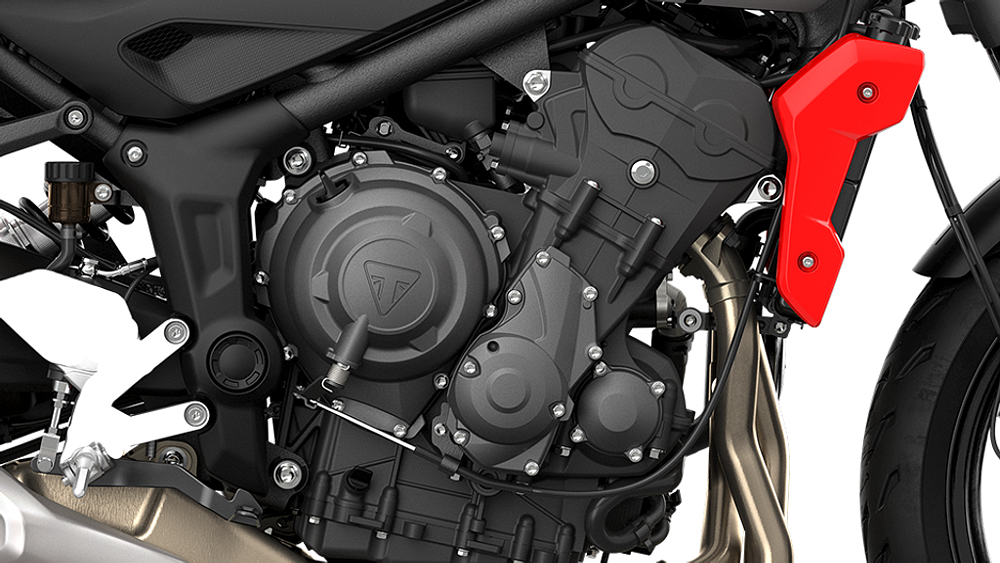
Don’t get me wrong, I still love the MT-07 engine and appreciate its wheel-lofting torque and great sound. Frankly, the motor’s rowdy demeanor is part of what makes it appealing, but when you ride it next to a bike as refined as the Triumph, it starts to feel crude rather than characterful.
Suspension, and what it means for handling
I would love to have been a fly on the wall while the Yamaha and Triumph techs were discussing and setting up their bikes’ suspension, because other than engine character, suspension action is the most dramatic difference between these machines. I imagine one team hurriedly selecting the lowest-priced option like a spectator choosing a beer during a timeout at a ballgame, while the other crew was actually swapping springs, evaluating damping curves, and doing on-road testing.

Jen already described the behavior and shortcomings of the MT’s fork and shock, so I won’t harp on it here, other than to specify that the fork in particular is underdamped and undersprung, with compression damping that’s too mushy on low-speed movement and harsh during high-speed hits — a textbook example of the downsides of damper-rod, orifice-style damping.
And yet, somehow, for nearly the same MSRP, Triumph slots actual shim stacks into the fork, with one leg handling compression damping while the other deals with rebound. It’s not a particularly sophisticated setup and there’s still no adjustability, but the support and control the fork and shock exhibit are head and shoulders better than on the Yamaha, with less dive and a more planted feel throughout a corner.
Part of that is no doubt due to the Triumph’s use of firmer springs which, depending on your weight, may be too stiff. I watched the wheels move up and down quickly and independently of the chassis while Zack and Spenser were on the Trident, then witnessed the chassis and rider getting rocked when Jen, who is considerably lighter, was onboard. Taking some preload out of the shock may have smoothed things out for her, but it’s worth noting that the Trident feels like it’s sprung for riders in the 180--to-200-pound range.
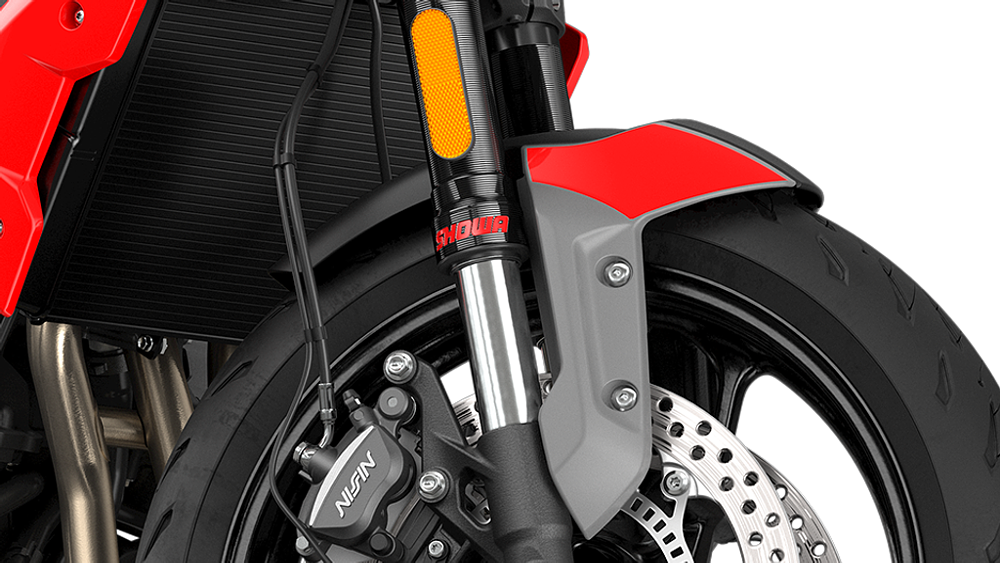
Both bikes respond easily to bar inputs, though the Triumph’s steering feels a bit odd. It’s quick to turn but then requires some bar pressure to hold a line, perhaps the result of steering geometry that has a steep head angle (24.6 degrees) with a longer (4.22-inch) self-centering trail figure.
The Yamaha is more nimble, but not nearly as planted. Mix in crummy throttle response and driveline lash, and it’s simply a harder bike to ride with any sort of precision, no matter how skilled a rider you are. On a challenging, technical road like Malibu’s Latigo Canyon, the Triumph’s superior refinement and composure enables it to slip away from the MT.
Oh, you want to slow down?
The MT-07 was graced with larger 298 mm discs (up from 282) for 2021 and the setup is plenty powerful, requiring only two fingers on the lever for maximum braking. Honestly, there were no complaints about the Yamaha’s brakes, and we all appreciated that the ABS was lenient enough to allow nose wheelies. The only problem with the MT-07’s stoppers is the Triumph’s.

At this point you may see a pattern developing, wherein the Triumph continually outpaces the Yamaha in terms of composure. The same goes for the brakes, which on the Trident are plumbed with braided stainless lines that likely contribute to the Triumph’s superior lever feel. There’s more power and more feedback from the Trident’s Nissins, and they’ve got the support of a better fork, so you can use them more aggressively.
Electronic whizbangs
Talking about the Yamaha’s electronic rider aids is easy, because it doesn’t have any. And for some riders, that’s appealing. No ride modes to mess with, no traction control to turn off, just a rambunctious little motorcycle and a pure riding experience. As mentioned earlier, it’s got ABS, and that’s all you really need. (Yes, I feel ABS is a necessity for street riding, though I’d like to be able to turn it off for track riding or hooning around.)
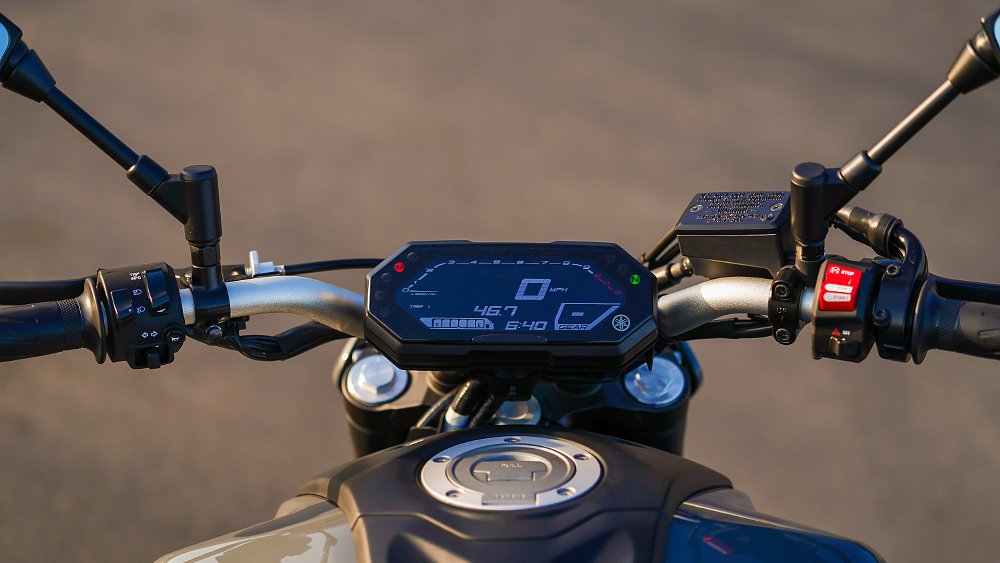
As far as electronics go, the 2021 MT-07 does have a new negative-LCD dash as well as LED turn signals. We love all of it. The dash is handsome and crisp and easy to read — if this is what can be done with LCD, who needs TFT? As for the signals, it seems Yamaha has finally run through its stock of the big, floppy, orange “bouncing pumpkin” indicators they’ve been using for decades and have moved on to slim, sleek LED units that will never burn out. Thank goodness!
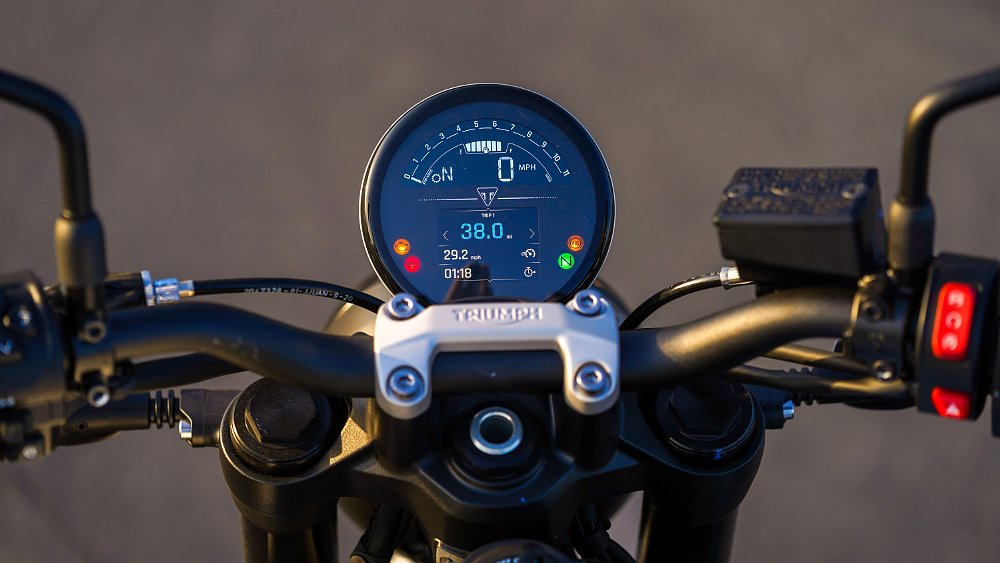
Triumph’s Trident is laden with rider aids, at least compared to most bikes in the naked 650 category. It has two ride modes, switchable TC, and (non-switchable) ABS, as well as GoPro and smartphone connectivity that’s all controlled via the TFT dash. The small dash, as well as the menu system it displays, were unanimously disliked by our group. From the tiny, hard-to-read font to the convoluted menu system, it was all frustrating. As an example, it took three tech-savvy riders an embarrassing amount of time to figure out how to set the clock. Maybe we’re not the smartest folks around, but that says something about how intuitive the menu system is.
Final thoughts
I’ll admit that when I first saw the Trident I wasn’t a fan of the bike’s curvaceous, organic lines. Spurg and I got into quite the adolescent back-and-forth about it on a Highside/Lowside podcast a while back, but I’ve warmed to the way it looks. Maybe my appreciation for the bike’s function is coloring my perception, the way my affection for my cat, Olive, makes everything about her so goddamn adorable.
It could also be that the Trident looks better in person than in photos. The tail is tidy, a round headlight is always attractive, and the fuel tank is a stylish new take on a classic shape. As with all Triumphs, the control cables and wiring are thoughtfully and neatly routed and each component seems to have been designed with a mind toward its contribution to the machine’s overall aesthetic. Even the bolt heads and other fasteners are stylized in a way that gives the bike a quality, dare I say premium, feel.
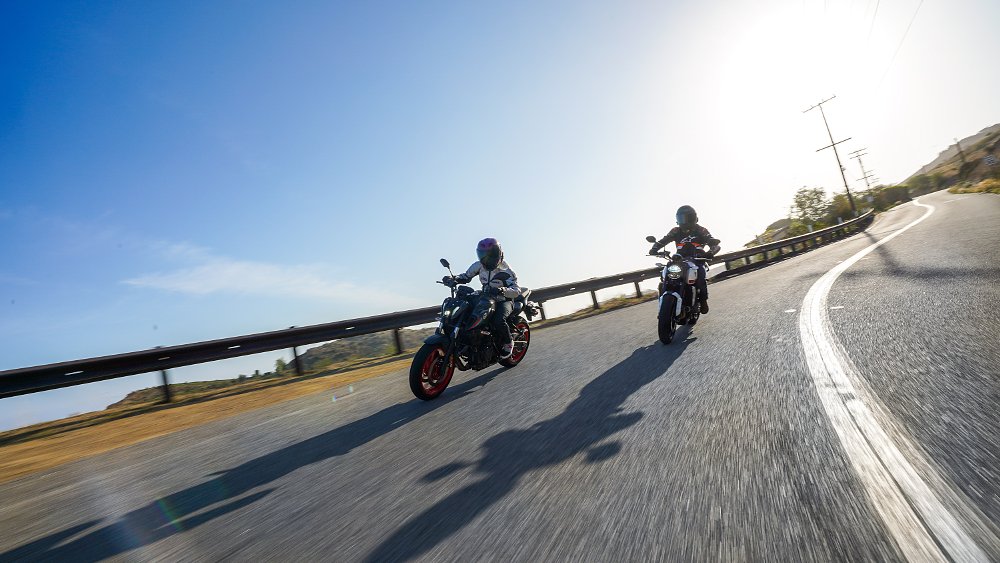
The MT-07 on the other hand is a bit more polarizing. I’ve yet to meet anyone who can say anything other than “Well, it’s different, so it has that going for it.” It’s really just the headlight assembly that throws people off. It looks like it’s preparing to squeeze through a small hole into an alternative universe or something…
As far as attention to detail, Yamaha took less care when routing the wires and cables. Like the riding experience, the MT-07’s appearance is a little unkempt.
Just to be clear, that unkempt, rowdy demeanor is part of what makes the MT-07 fun. It’s the rubbery, frolicking puppy to the Trident’s mature and relaxed dog. In the end, the MT-07 is cheaper by about $400, which is much smaller than the delta between the bikes’ function and performance. As with most Triumphs, the Trident works well enough to make you feel like a better rider.
And at this price point, that’s saying a lot.
Bull’s eye.
| 2021 Triumph Trident | 2021 Yamaha MT-07 | |
|---|---|---|
| Price (MSRP) | $8,095 | $7,699 |
| Engine | 660 cc, liquid-cooled triple, four valves per cylinder | 689 cc, liquid-cooled parallel twin, four valves per cylinder |
|
Transmission, final drive |
Six-speed, chain | Six-speed, chain |
| Claimed horsepower | 80.0 hp @ 10,250 rpm | NA |
| Claimed torque | 47.0 foot-pounds @ 6,250 rpm | NA |
| Frame | Tubular-steel perimeter | Tubular-steel double-backbone |
| Front suspension | Showa 41 mm fork; 4.7 inches of travel | KYB 41 mm fork; 5.1 inches of travel |
| Rear suspension | Showa shock, adjustable for spring preload; 5.3 inches of travel | KYB shock, adjustable for spring preload; 5.1 inches of travel |
| Front brake | Nissin two-piston calipers, 310 mm discs with ABS | Advics two-piston calipers, 298 mm discs with ABS |
| Rear brake | Nissin single-piston caliper, 225 mm disc with ABS | Nissin one-piston caliper, 245 mm disc with ABS |
| Rake, trail | 24.6 degrees, 4.22 inches | 24.5 degrees, 3.5 inches |
| Wheelbase | 55.2 inches | 55.1 inches |
| Seat height | 31.7 inches | 31.7 inches |
| Fuel capacity | 3.7 gallons | 3.7 gallons |
| Tires | Michelin Road 5, 120/70R17 front, 180/55R17 rear | Michelin Road 5, 120/70ZR17 front, 180/55ZR17 rear |
| Measured weight | 428 pounds | 406 pounds |
| Available | Now | Now |
| Warranty | 24 months | 12 months |
| More info | Triumphmotorcycles.com | yamahamotorsports.com |






